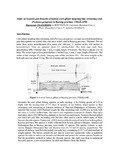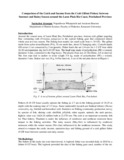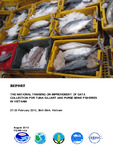| dc.identifier.citation | Chanchiem, T., Boutson, A., Kaewnern, M., Ebata, K., & Arimoto, T. (2015). Study on bycatch and discards of bottom crab gillnet targeting blue swimming crab (Portunus pelagicus) in Rayong province, Thailand. SEAFDEC Technical Seminar 2015 (pp. 9-11). Samut Prakan: Training Department, Southeast Asian Fisheries Development Center. | en |
| dc.description | Crab gillnet targeting blue swimming crab (Portunus pelagicus) is a small scale traditional fishing gear that operates on seabed which the most widely used in Rayong province, Thailand. The net made from nylon monofilament (PA, mesh size 100 mm, 12 meshes depth, 450 meshes in horizontal/net). They are operated about 3-5 sets/day/fisher. The head rope made from polyethylene (PE) z twisted (dia. 3 mm, 2 ropes, length 450 m/set). The float is plastic (38×10 mm). The sinker rope is from polyethylene z twisted (dia. 4 mm, 1 rope, length 450 m/set). The sinker is lead (weight 10 g/lead). Hanging ratio of the net about 50% . The stone weights at the both side ends are about 5-8 kg. Generally the crab gillnet fishing operates in early morning in the fishing ground of 5-25 m depth with the socking time of 3-5 days. It operates at sea bottom, target species is blue swimming crab. According to fisheries statistics of Thailand (Department of fisheries, 2012) reported that in year 2010 Thailand caught the blue swimming crab 22,800 tons in total, with the value of 2,520.7 million baht. The crab is very important economic for fishers. They have high price, about 100-300 baht/kg, depends on the crab size and season. However the crab gillnet can catch not only blue swimming crab but also other marine species which many of them become discards species. Puntip et al. (2013) surveyed the diversity of crabs from bottom gillnet, Rayong province, The species of crabs collected from bottom gill net at Banpae, Suanson and Makampom Bay in Rayong province were totally 83 species. The species richness in each station, Banpae, Makampom Bay and Suanson were 65, 52 and 48 species, respectively. The species of crabs as trash fish (discarded) was quite high comprising 81.93 % of total numbers of caught species. The fishers actually do not want to catch non- marketable value or undersize species. In order to reduce the bycatch and discards and protect the marine species, besides to find the possibility methods to reduce the discards species, this study was done to understand the catch species, catch compositions, bycatch and discards from this fishery. | en |




